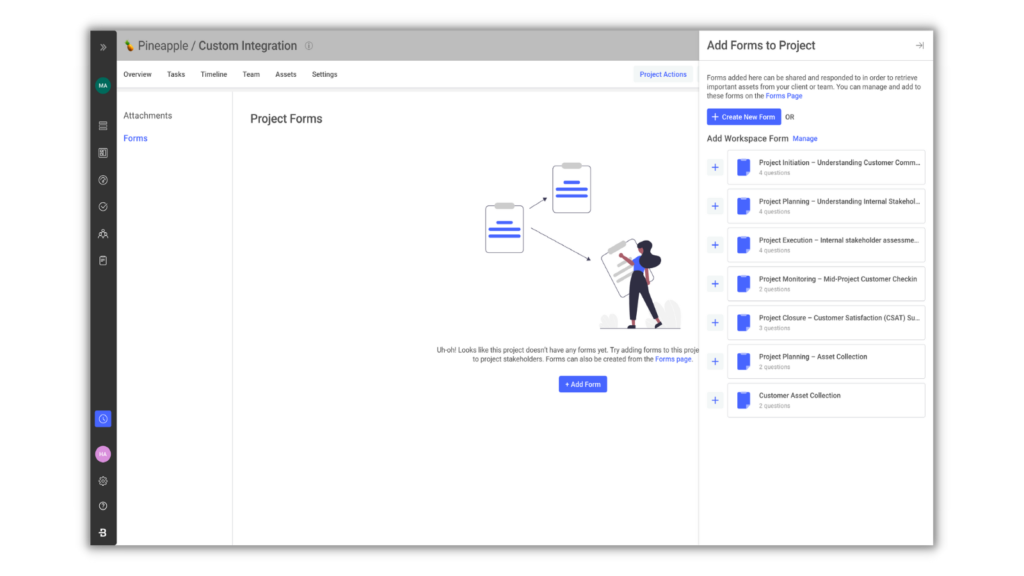Embarking on a software implementation and client onboarding project is no easy feat. The success of such endeavors hinges on meticulous planning, clear understanding, and strategic execution. At the heart of this preparation lies a critical phase known as Project Discovery. Often underestimated, this initial step plays a pivotal role in shaping the entire trajectory of the project. In this blog, we’ll delve into the multifaceted importance of Project Discovery before venturing into the realms of software implementation and client onboarding.
What Is Project Discovery?
Project Discovery is the phase where key stakeholders, implementation managers, and the development team come together to gather and analyze information. It involves a deep dive into the client’s business processes, requirements, expectations, and challenges. This phase is not only about identifying the technical aspects but also understanding the client’s vision, objectives, and the broader industry landscape.
Laying the Foundation for Implementation Success
The foundation of any successful project is laid during the Project Discovery phase. It provides an opportunity to align all stakeholders on the project’s goals and objectives. Through detailed discussions and workshops, the team gains a comprehensive understanding of the client’s business model, workflows, and pain points. This clarity sets the tone for the entire project, ensuring that the subsequent stages are built on a solid foundation.
Risk Mitigation and Issue Anticipation
Project Discovery serves as a risk mitigation strategy by identifying potential challenges early in the process. By thoroughly examining the client’s requirements, the team can anticipate issues that may arise during the implementation phase. This proactive approach enables the formulation of contingency plans and ensures a smoother journey through the development lifecycle. It’s the difference between navigating turbulent waters with a detailed map and sailing blindly into unknown territory.
Defining Project Scope and Deliverables
A well-defined scope is crucial for project success. Through Project Discovery, the team can precisely outline the project’s scope, including features, functionalities, and deliverables. This not only helps manage client expectations but also serves as a reference point throughout the project’s lifecycle. Clear documentation from the discovery phase becomes the guiding light, preventing scope creep and ensuring that the project stays on track.
Client-Centric Solutions
Understanding the client’s business intricacies is at the core of Project Discovery. This insight allows the development team to tailor solutions that align with the client’s specific needs. It’s not just about providing a generic software product but crafting a bespoke solution that addresses the unique challenges and goals of the client. By putting the client at the center of the development process, Project Discovery ensures that the end product is not only technically sound but also adds significant value to the client’s operations.
Enhancing Communication and Collaboration
Effective communication is the backbone of successful projects. Project Discovery fosters collaboration among stakeholders, building a shared understanding of the project’s intricacies. Regular meetings, workshops, and brainstorming sessions during this phase lay the groundwork for a collaborative environment that extends throughout the project’s lifecycle. Clear communication channels established in the discovery phase help in avoiding misunderstandings and facilitate a smoother workflow.
Resource Planning and Allocation
Project Discovery provides valuable insights into the resources required for the project. Whether it’s the expertise needed from the development team, specific technologies, or external resources, a detailed understanding of requirements allows for efficient resource planning and allocation. This ensures that the right people with the right skills are involved in the project, contributing to its success.
Asset Collection and Documentation
Detailed documentation serves as the blueprint for the entire project. During Project Discovery, emphasis is placed on collecting and reviewing existing documentation related to business processes, system architecture, and user requirements. This not only aids in understanding the client’s operations but also serves as a reference point for the development team throughout the project lifecycle. Clear and thorough documentation is the scaffolding upon which the entire project structure is erected.
Budgeting and Timeline Estimation
Accurate budgeting and timeline estimation are critical aspects of project management. Project Discovery helps in creating a realistic project plan by identifying all the components involved and estimating the time and resources required. This not only prevents unexpected budget overruns but also sets realistic expectations for the client regarding the project’s timeline.
Collecting Client Feedback and Expectations
Project success is not solely measured by meeting technical specifications but also by aligning with stakeholder expectations. Project Discovery provides a platform for engaging with key stakeholders, understanding their priorities, and incorporating their input into the project plan. Understanding the end-users is paramount to creating a successful software solution. Project Discovery involves gathering user feedback, preferences, and expectations. This can be achieved through interviews, surveys, or usability testing. By incorporating user perspectives into the early stages of the project, the team ensures that the final product not only meets technical specifications but also resonates with the intended audience, fostering user satisfaction and adoption.
Leveraging Purpose-Built Implementation Management Solutions for Enhanced Project Discovery
In the ever-evolving landscape of software implementation and client onboarding, technology has become both the driver and the enabler. One pivotal aspect that can significantly elevate the effectiveness of the Project Discovery phase is the integration of purpose-built implementation management solutions. These specialized tools not only streamline the process but also enhance collaboration, communication, and decision-making, thus turning Project Discovery into a more dynamic and efficient endeavor.

Centralized Information Hub
Purpose-built implementation management solutions act as a centralized hub for all project-related information. This includes documentation, stakeholder input, asset collections, and other critical data points. Having a centralized repository ensures that all team members, regardless of their physical location, have access to the latest and most accurate information. This fosters collaboration and eliminates the risk of miscommunication or working with outdated data.
Collaborative Workspaces for Stakeholder Involvement
These solutions often come equipped with collaborative workspaces and client portals that facilitate real-time interaction among project stakeholders. During the Project Discovery phase, this feature allows for seamless communication and collaboration between the development team, project managers, and clients. Stakeholders can provide instant feedback, share insights, and actively participate in the decision-making process, fostering a sense of transparency and inclusivity.
Integrated Communication Channels
Effective communication is the bedrock of successful projects, and purpose-built solutions offer integrated communication channels that transcend traditional email threads. This is particularly beneficial during Project Discovery, where constant communication and quick decision-making are crucial. These tools often include chat features, discussion boards, and notifications, ensuring that everyone involved is on the same page and that important information is disseminated promptly.
Workflow Automation for Efficiency
Implementation management solutions frequently come equipped with workflow automation capabilities. This is a game-changer during Project Discovery, where repetitive tasks such as data collection, documentation updates, and progress tracking can be automated. This not only reduces the risk of human error but also allows team members to focus on more complex and strategic aspects of the discovery phase, enhancing overall efficiency.
Real-Time Analytics and Reporting
Understanding project metrics is essential for informed decision-making. Purpose-built solutions often offer real-time analytics and reporting features, providing project managers and stakeholders with insights into the progress of the Project Discovery phase. This data-driven approach allows for quick adjustments, identification of potential bottlenecks, and ensures that the project stays on course.
Customization to Fit Project Needs
Every project is unique, and purpose-built solutions recognize this diversity. These tools often come with customization options, allowing organizations to tailor the system to fit the specific needs of their software implementation and client onboarding projects. This flexibility ensures that the solution aligns seamlessly with the intricacies of the Project Discovery phase, accommodating various workflows and project requirements.
Security Measures for Confidential Data
Security is a paramount concern, especially when dealing with sensitive client data and proprietary information. Purpose-built implementation management solutions typically include robust security measures to protect confidential data. This is particularly crucial during the Project Discovery phase when a vast array of information is collected and analyzed. Ensuring the security of this data instills confidence in both clients and internal stakeholders.
Elevating Project Discovery Through Purpose-Built Technology Solutions
As the digital landscape continues to evolve, leveraging purpose-built implementation management solutions becomes not just a choice but a strategic imperative. Incorporating these tools into the Project Discovery phase of software implementation and client onboarding projects enhances collaboration, communication, and overall efficiency. The result is a more streamlined and dynamic discovery process that sets the stage for success in subsequent project stages. By embracing technology to augment Project Discovery, organizations position themselves at the forefront of innovation, ensuring that they not only meet but exceed client expectations in the ever-competitive realm of software development and client onboarding.



